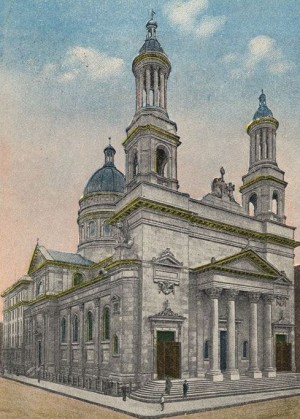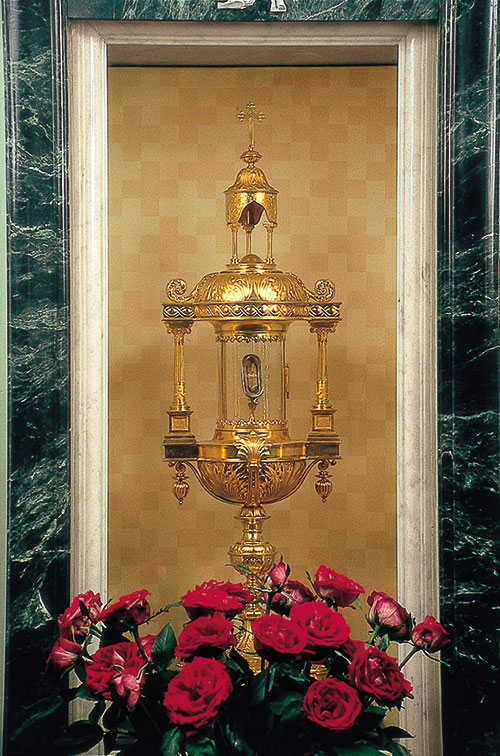Americans’ Devotion to St. Anne
St. Anne’s Shrine in New York City Tells the Tale, Complete With a Relic

Many visitors to New York City come to see the Statue of Liberty, St. Patrick’s Cathedral and the Empire State Building, but there are so many more sites that offer a truly profound spiritual experience. Among the many jewels in New York’s ecclesial crown is the Church of St. Jean Baptiste on 76th Street and Lexington on Manhattan’s Upper Eastside.
A few blocks from the Metropolitan Museum, this treasure trove might be a little bit off the beaten tourist path, but time spent there is time spent well.
I came to know about St. Anne’s Shrine at the church through a friend who has a great devotion to St. Anne. In fact, he ascribes his conversion to Catholicism and the many miracles in his life to her intercession.
Built in the Italian Renaissance-style, St. Jean Baptiste’s interior is redolent with French motifs, and its stained glass rivals the magnificent windows at Chartres and Sainte-Chapelle. In fact, St. Patrick’s Cathedral and St. Jean Baptiste are the only two New York churches with stained-glass windows from the Lorin Studies of Chartres (1914-1919.) All other authentic stained glass for New York City churches was made in the Munich school. In the center of the nave, four stories above the congregation, is the church’s glorious dome. Next to it is a reproduction of Gustave Doré’s Celestial Rose, a huge, light-infused, nebulous image of God in his glory, as described in Dante’s Paradisio.

Shrine of St. Anne
Though the overall size of the St. Anne Shrine is minuscule compared to the cavernous church around it, its simplicity and serenity draws one in. The most striking aspect of the shrine is its half-dome ceiling; a field of deep cerulean blue, decorated with large gold stars.
The effect is that of twilight: the time St. Bonaventure teaches that the Archangel Gabriel appeared to Mary. The white marble railing in front of the shrine is beautifully embellished with the Eucharistic symbols of wheat and grapes. The theme of the shrine’s two stained-glass windows reflect St. Anne’s position, as the mother of Mary, as the last of the Old Testament matriarchs. The left window depicts the Paschal Lamb, while the right one depicts the Ark of the Covenant, the symbol of God’s abiding presence in the midst of his people.
A single statue stands in the spacious alcove depicting Mary as a child standing in front of Anne and pointing up at her. The statue was donated by Canon Petit. The Italian sculptor Luca Vescia carved the statue from a single block of Carrara marble. Whereas many iconic traditional representations of Christ are as a small adult in his mother’s arms, this statue depicts Mary as a very happy child, with a fleshy embonpoint not often see in Christian iconographic statuary. There’s almost a cute merriment about her as she points to her mother, as if saying, “That’s my mom!”
Mary’s interlocutor stance reminds the viewer that she is the Immaculate Conception and St. Anne was she who was graced to bear this child, preserved from original sin from the first instant of her conception.
The statue beautifully juxtaposes Mary’s childlike joy and Anne’s dignified grace and gratefulness that is best expressed in tears of joy. Anne’s face is heavy with years, but each wrinkle testifies to the love and devotion she has for her child, her grandchild and her Creator. It’s easy to see all of our grandmothers in the statue’s face. If Mary is the mother of us all, than St. Anne is humanity’s grand-mère.
Who couldn’t love a grandmother?
Considering this universal reverence, it only follows that we as a Church would want to know about Christ’s grandparentage: The feast day of Christ’s maternal grandparents, Sts. Anne and Joachim, is July 26.
The Protoevangelium of St. James describes Joachim as a rich farmer, herdsman and a native son of Nazareth. Akar, Anne’s father, gave up his nomadic ways and brought his wife to Nazareth to give birth to their daughter. After Joachim married Anne, the couple was childless. After fervent prayers on both of their parts, an angel appeared to Anne, assuring her that she would give birth to a child who would be praised throughout the world. At that, Anne replied to the angel that she would raise the child as a gift to God, dedicating the child to serve him in holiness. At the same moment, another angel delivered the same message to Joachim, who then ran home to share the news with Anne. The child, of course, was Mary, who would become the Mother of God.
Tradition teaches that the blessed grandparents lived to see Jesus’ birth and subsequent dedication at the Temple at Jerusalem.
St. Anne Relics
According to Tradition, in 710, St. Anne’s body was disinterred from Palestine and brought to Constantinople. From there, smaller relics were dispersed throughout the West. A small piece of her arm bone is housed in a reliquary to the right of the shrine at St. Jean Baptiste Church. The antique reliquary is supported by a gold dolphin, sculpted in 1997 by Armand Guior. Though there are many churches in America, and even in New York City, which are dedicated to St. Anne, this is the only one that contains her relics.
On May 1, 1892, Msgr. J.C. Marquis arrived at St. Jean Baptiste with a relic of St. Anne that Pope Leo XIII had given him. He was on route to Beaupré, near Quebec, to install the relic at that shrine. While the monsignor rested, St. Jean’s pastor, Father Tetreau, wished to expose the relic during vespers that evening. Msgr. Marquis’ original intention was to leave the next day, but the news that the relic was to be exposed drew crowds so huge that secular newspapers of the day reported the event. The crowds were estimated between 200,000 and 300,000. On the first evening of the exposition, it was reported that a young man was cured of epilepsy. For three weeks, the church was filled to capacity by pilgrims eager to view the relic. Msgr. Marquis was so moved by the devotion of the exuberant crowds that he promised to arrange for a relic to be brought to St. Jean Baptiste.
He showed Pope Leo XIII the newspaper articles attesting to Americans’ devotion to St. Anne and begged him for another relic. The pope gave permission for the monsignor to sail to France to receive one from the shrine of St. Anne d’Apt. Once the relic was installed at St. Jean Baptiste, miraculous healings were reported once again.

12,000-13,000 people are expected every year for a St. Anne novena and for Sts. Anne and Joachim’s feast day.
St. John’s offers a splendid opportunity to step out of frenetic streets of New York and into the cool, enveloping, reverential silence that is God’s language. It’s just like a grandmother’s welcoming embrace.
Angelo Stagnaro writes from New York.
- Keywords:
- new york city
- relics
- st. anne
- sts. anne and joachim
- travel

















